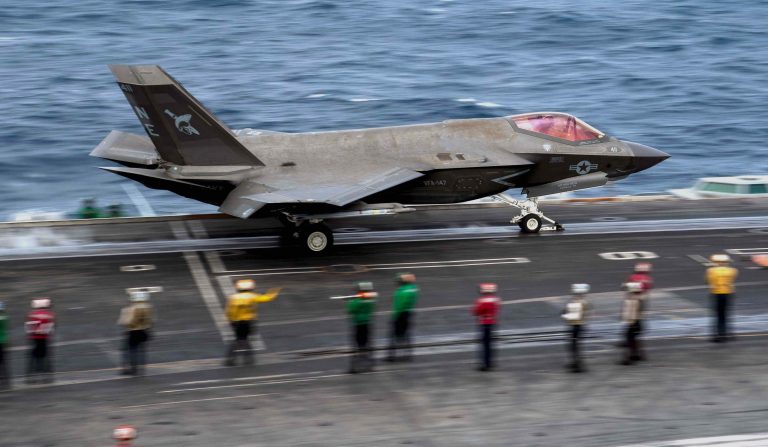The U.S. Navy is racing to retrieve an advanced F-35C fighter jet from the bottom of the South China Sea after it crashed on an aircraft carrier and plunged overboard – taking with it highly classified technology worth over $100 million.
The F-35C crash-landed on the deck of the aircraft carrier USS Carl Vinson during routine military operations on Jan. 27, the Navy said. The accident injured six sailors as well as the pilot, who managed to eject himself from the plane before it splashed into the ocean. All injured parties are reported to be in stable condition and undergoing recovery.
“An F-35C Lightning II assigned to Carrier Air Wing (CVW) 2, embarked aboard USS Carl Vinson (CVN 70) had a landing mishap and impacted the flight deck and subsequently fell to the water during routine flight operations,” a statement released by the U.S. Navy said.
Possible boon for Beijing
The most advanced US fighter of its kind, the stealth plane is packed with cutting edge technology, and if found could represent a win for China – which claims almost all of the South China Sea as its own territory. According to the Navy, the Vinson was on a patrol with the intention of “challenging [China’s] territorial claim and defend international freedom of navigation.”
The F-35C is a version of the plane specially designed to operate from aircraft carriers. Maritime experts have said it could take a US salvage ship more than 10 days to reach the site of the crash, potentially giving Chinese submarines the opportunity to find it first.
Success
You are now signed up for our newsletter
Success
Check your email to complete sign up
“We’re certainly mindful of the value of an F-35 in every respect of what value means,” John Kirby, Pentagon spokesman said yesterday. “And as we continue to attempt recovery of the aircraft we’re going to do it obviously with safety foremost in mind, but clearly our own national security interests. And I think I will just leave it at that.”
Beijing: America should stop ‘flexing muscles’ in the region
Meanwhile, in Beijing, foreign ministry spokesman Zhao Lijian said the Chinese government had no intention of searching for the crashed plane. “I noted relevant reports. This is not the first time that the US has had an accident in the South China Sea,” he said.
“We have no interest in their aircraft. We urge the country concerned to do things that are conducive to regional peace and stability, rather than flex muscles in the region.”
Still, US national security experts believe the Chinese military would be “very keen” to get to the jet first. However, a successful salvage mission could take more time as murky waters and low visibility at the crash site complicate search efforts.
“That’s too long,” says defense consultant Abi Austen, pointing out that the aircraft’s black box battery would die before then, making it harder to locate the aircraft.
“It’s vitally important the US gets this back,” Austen told BBC. “The F-35 is basically like a flying computer. It’s designed to link up other assets – what the Air Force calls ‘linking sensors to shooters’.”
China doesn’t have this technology and so getting their hands on it would give them a huge leap forward, she said, adding that “If they can get into the 35’s networking capabilities, it effectively undermines the whole carrier philosophy.”
This is the third time an F-35 jet has crashed into the sea and had to be salvaged.
In November of last year, a British F-35B crashed into the Mediterranean after losing power while taking off from the aircraft carrier HMS Queen Elizabeth. The pilot ejected from the plane and was rescued from the water by a helicopter. The jet was recovered from the seabed a few weeks later.
In April 2019, a Japanese F-35A, the conventional takeoff and landing version, crashed at speeds of over 600 miles per hour into the Pacific ocean, killing the pilot and leaving only a wreckage in its wake.














